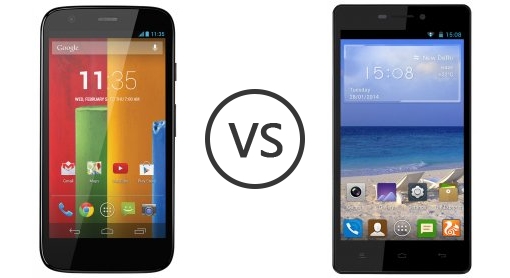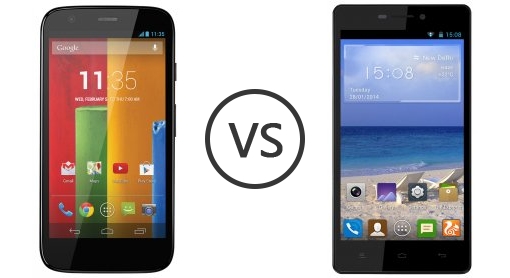
So far, 2014 has been a great year for budget smart phones. Large electronics corporations such as Motorola (Moto G) and reliable Chinese companies such as Gionee (Gionee M2) have shown immense interest in the lower end mobile phone market and captured the attention of one and all. They have delivered models that have already made an impact on the buyers.
It may be argued that these attractive little power houses are not comparable to the big players in the market, but they are worth every buck you spend on them. But then , what makes them rock? What are the stand-out points that give them the edge over other phones in the fray (and each other)? Are they really worth your dough?

Here are a few specifications which make them good value for money and set them apart in the highly competitive budget smart phone market space.
Price
Both Moto G and Gionee M2 are similarly priced – while the 16 GB Moto G costs about Rs. 11,999, the Gionee M2 comes with a price tag of Rs. 11,110. The pricing is in tandem with similar specifications offered by both the phones.
Both Moto G and Gionee M2 are available throughout the country, as is the after sales service for them.
However, Motorola is considering pulling out the Moto G in favor of a more advanced Moto G2, which they plan to introduce sometime next year.
So, before you click on pay, take a pause and think twice –as far as the price is concerned, they are neck-to-neck. What next?
Connectivity
Both phones have dual SIM capabilities. While Moto G requires the user to put in a Micro SIM, Gionee M2 offers the advantage of using one Micro SIM and one regular GSM SIM card. However, Moto G offers both GSM and CMA in 2G, while the Gionee M2 offers only GSM in 2G.
While Moto G is equipped to offer 21.1 Mbps HSDPA and 5.76 Mbps HSUPA in 3 G ; Gionee M2 offers only HSPA in 3G. Both phones have similar Wi-Fi and v4 Bluetooth connectivity.
Memory and other Specifications
The Moto G is a comparably better phone out of the two in this aspect. Boasting of 16 GB/ 8GB internal memory, 1 GB RAM and the android v.4.4 (Kit Kat) operating system, it has a slight edge over its counterpart in the reckoning. In comparison, the Gionee M2 comes with a 4 GB internal memory, 1 GB RAM and operates on the android v.4.2 (Jelly Bean) operating system.
However, The Moto G does not offer an option of expanding the memory, as compared to the Gionee which offers up to 32 GB expandable memory via the micro SD card. The Moto G offers the 1.2GHz, Qualcomm Snapdragon quad core processor and the Gionee M2 houses the 1.3GHz Corex-A7 quad core processor. Both phones are equally fast and most programs on them run without any noticeable lag.
The phone memory dedicated for messages and contacts is quite good, providing almost unlimited phone contacts and call records storage. Although the Moto G offers 16 GB of internal memory, only about 12 GB is available for the user as the rest is used up by the phone operating system and internal programs.
Body
As can be expected in the budget smart phone market, both the phones do not boast of the best feel and texture–especially when it comes to looks and body features. The overall finish seems a little flimsy, and the body does not seem like it can take much of a beating. Considering that most phone users in this range are not regular changers of their existing models, it would make more sense to offer a stronger body that would last long.
For example, a strong back cover could solve this problem. The back covers are removable in both phones, and they certainly feel flimsy in the hands. While the Moto G is lighters at 140 grams as compared to the Gionee M2 which weighs in on the heavier side at 200 grams, neither phones are bulky, and fit quite well into the average hands.
Battery
While Moto G does give an option to remove the back panel, it does not offer the feature of a removable battery. Gionee M2 on the other hand has a removable battery and a micro SD slot that is extendable up to 32 GB. The phones run on lithium ion battery( as is the norm), with the Moto G offering a 2070mAH battery and the Gionee M2 a 4200mAH battery.
The Gionee M2 is superior in this regard as the battery can last up to 31 hours of talk time in 2G mode and a talk time of 24 hours in 3G mode. Both phones support the 3.5mm audio jack, and offer FM radio.
Display
Display is not something to brag about in either of the phones. That being said, you get what you paid for. Both phones have a very responsive TFT capacitive touch screen and color specification of 16M. However, the similarities end there. The Moto G comes with the sturdy gorilla glass 3, which ensures that the display is sturdy and does not crack easily. The Gionee M2 lacks the Gorilla glass, but is scratch resistant.
Both phones have good luminosity and do not pose a problem when used in well-lit areas. The Moto G comes with a screen resolution of 720 x 1280 pixels (326 ppi) while the Gionee M2 settles for 480 x 854 pixels (196 ppi). With a display screen of 4.5 inches, the Moto G is slightly smaller than the Gionee M2 that boasts of a larger display size of 5 inches. However, Moto G has a full frame display which is lacking in the Gionee M2.
Graphics are well supported in both the phones with the Adreno 305, 450 MHz Single Core providing the graphics support in Moto G, and Mali- 400 MP handling the graphics in Gionee M2.
Camera
Motorola seems to have cut costs in this segment, providing the Moto G with a 5 MP primary camera and a 1.3MP front camera. The camera specifications in Gionee M2 are definitely better, offering an 8 MP primary camera and a 2 MP front camera.
As can be expected, the quality of the photos suffers in low light but comes out extremely well in well-lit situations. However, it must be remembered that while all smart phones offer cameras, they are still phones and not a camera. Both phones come with the LED flash and are capable of shooting videos in HD (720 x 1280, 30 fps).
The Moto G offers additional camera features such as Auto focus, HDR, Slow motion video capture, Panorama and tap to focus. Gionee M2 has on offer additional specifications such as face detection, eraser, touch focus, burst mode, geo tagging, gesture shot and smile shot.
Multimedia Support
Both phones support a wide variety of audio and video formats. The Moto G supports mp3, mp4, DivX, VC1, WMV9, H.264 and the Gionee M2 supports mp3, mp4, avi, 3GP, H.263, H.264. Although both the phones have FM players, the Gionee M2 also offers FM recording.
However, the pre installed music player in Moto G is better than that in Gionee M2. The music player offered in the Gionee M2 lacks an equalizer, which will definitely be irksome if you are an avid music lover. However, since both the phone allow for third party music player downloads, downloading a good music player should counter this problem quite well.
Way Forward
In context with the budget constraints, both the phones offer a good deal of goodies which should attract the discerning buyer. So, now you need to have a clear idea about your immediate needs and align them with the features on offer.
Go in for the one that bests suits your personality, preference and purpose alike.
All the best.